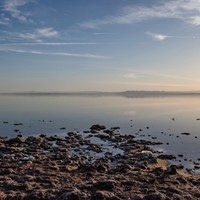Wednesday, January 28, 2009
A Post-Dams World
Posted By Heidi Walters on Wed, Jan 28, 2009 at 7:27 PM

In some people's nightmare's, ya take down the Klamath Dams and a world-engulfing blob of hell-deep muck that's accumulated around that dam for too many years will engulf the downriver world, smothering all salmon, salmon fry, lamprey, lamprey younguns, and everyone else silly enough, in that scenario, to call the Klamath River home. And, oh, the floods!
A soggy apocalypse.
Hey -- please don't have that nightmare anymore. It's freaky. And, besides, three reports that have just come out seem to allay some of those dam-removal fears. According to a joint news release from the Karuk Tribe and American Rivers, the reports -- which were commissioned by the California Coastal Conservancy -- conclude that the removal of four large dams on the Klamath River will have "relatively minor" short-term negative impacts on the fisheries but no major long-term impacts.
Most remarkably, the groups say sediment removal won't be required.
Quoth the release:
The Water Quality report shows that the removal of the dams would:
- Eliminate or greatly reduce toxic blue green algae production.
- Greatly alleviate releases of harmful nutrients from oxygen-starved reservoirs.
- Significantly decrease summer and fall water temperatures, from 4-7° F.
- Substantially increase dissolved oxygen levels.
- Reduce dramatic fluctuations of pH levels.
- Likely reduce levels of fish disease-causing parasites.
The Downstream Biological Impacts study concludes that although fish populations will suffer some negative impacts immediately following removal, this effect will be short lived. Specifically,
- Impacts to fall Chinook will be short-term, and the population should fully recover to pre-removal levels within five years.
- Spring-run Chinook should experience rapid recovery to pre-dam removal stock levels.
- Coho salmon should experience only short-term effects and populations will recover fully.
- Steelhead populations could be highly affected but should experience a strong recovery.
- Pacific lamprey are expected to recover relatively quickly from impacts.
The Sediment Transport analysis concludes that:
- Less than 1/3 of the sediment trapped by the dams will be transported downstream.
- Nearly all of the sediment that is transported will travel directly to the ocean without being deposited in the river.
- Flood risk will not be increased appreciably.
- Sediment concentrations will likely be significant during the first winter after reservoir drawdown.
This sounds promising, especially since
PacifiCorp recently has come around to the notion of taking down those dams.
Speaking of Environment, Science
Readers also liked…
more from the author
-
From the Journal Archives: When the Waters Rose in 1964
- Dec 26, 2019
-
Bigfoot Gets Real
- Feb 20, 2015
-
Lincoln's Hearse
- Feb 19, 2015
- More »


































